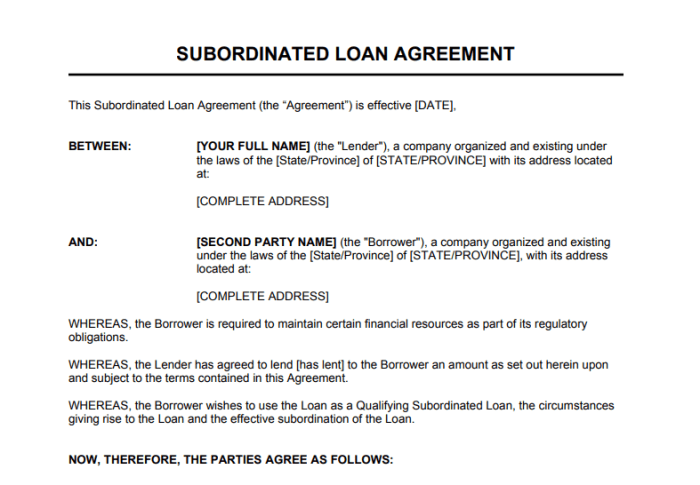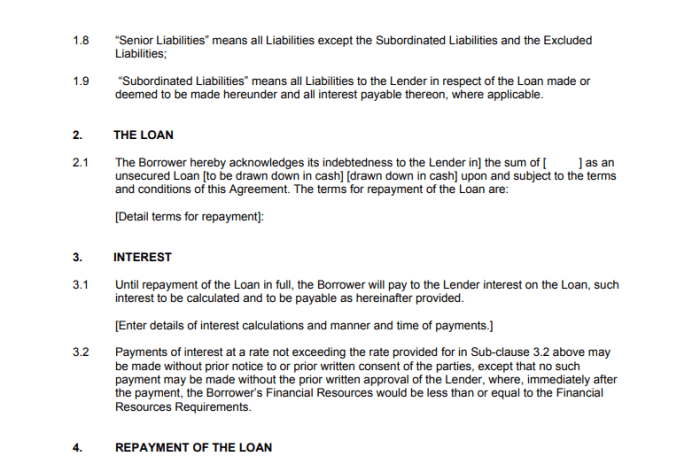A subordination agreement is a written agreement between lienholders to alter the priority of their respective liens on a particular asset. This legal instrument provides a framework for lienholders to establish a hierarchy of claims, ensuring that each party’s rights are clearly defined and protected.
Subordination agreements are commonly utilized in various financial transactions, such as real estate financing, secured lending, and corporate restructurings. They offer flexibility in structuring complex financing arrangements and mitigating potential conflicts among lienholders.
Definition of a Subordination Agreement
A subordination agreement is a written contract between lienholders that establishes the priority of their respective liens on a specific property or asset. It alters the typical “first-in-time, first-in-right” rule, allowing a junior lienholder to take precedence over a senior lienholder in terms of repayment.
Purpose and Benefits of a Subordination Agreement, A subordination agreement is a written agreement between lienholders to
- Allows a junior lienholder to secure financing without affecting the priority of the senior lienholder.
- Facilitates additional lending or investment in a property or asset.
- Provides flexibility in financing arrangements and can help avoid foreclosure.
Key Elements of a Subordination Agreement
- Identification of Parties:Names and contact information of the senior and junior lienholders.
- Description of Property:Clear description of the property or asset subject to the subordination.
- Subordination Clause:Explicit statement that the senior lienholder subordinates its lien to the junior lienholder.
- Priority of Liens:Specifies the new order of priority among the liens.
- Consideration:Any compensation or benefit provided by the junior lienholder to the senior lienholder in exchange for the subordination.
Parties to a Subordination Agreement
- Senior Lienholder:The party holding the original, higher-priority lien.
- Junior Lienholder:The party seeking to subordinate its lien to the senior lienholder.
Roles and Responsibilities
- Senior Lienholder:Agrees to give up its priority position to the junior lienholder.
- Junior Lienholder:Provides consideration to the senior lienholder and becomes the new priority lienholder.
Types of Subordination Agreements
- Partial Subordination:Senior lienholder subordinates its lien only up to a specified amount or portion of the property.
- Full Subordination:Senior lienholder completely subordinates its lien to the junior lienholder.
- Cross-Subordination:Multiple lienholders agree to subordinate their liens to each other, creating a rotating priority.
Negotiation and Execution of a Subordination Agreement

- Negotiation:Parties discuss the terms, including consideration, priority, and any conditions.
- Legal Counsel:It is advisable to seek legal advice to ensure the agreement is drafted and executed properly.
- Execution:Once the terms are agreed upon, the parties sign and notarize the agreement.
Enforcement and Remedies for Breach
- Specific Performance:Court order requiring the senior lienholder to honor the subordination agreement.
- Damages:Monetary compensation for any losses incurred due to a breach.
- Injunction:Court order preventing the senior lienholder from taking actions that violate the agreement.
Practical Applications of Subordination Agreements: A Subordination Agreement Is A Written Agreement Between Lienholders To

- Construction Financing:Subordination agreements allow junior lenders to finance construction projects without affecting the priority of existing mortgages.
- Business Loans:Subordination agreements enable businesses to obtain additional financing while maintaining the priority of existing creditors.
- Estate Planning:Subordination agreements can be used to prioritize the distribution of assets among heirs.
Alternatives to Subordination Agreements

- Intercreditor Agreement:An agreement between multiple creditors that establishes the priority of their claims without subordination.
- Equity Financing:Raising capital through the sale of ownership shares rather than debt.
- Guarantees:Third-party guarantees can provide additional security to junior lenders without subordinating existing liens.
Essential FAQs
What is the purpose of a subordination agreement?
A subordination agreement is used to alter the priority of liens on an asset, establishing a hierarchy of claims among lienholders.
Who are the parties involved in a subordination agreement?
The parties involved are typically lienholders, such as mortgage lenders, judgment creditors, or other entities with a legal claim on an asset.
What are the key elements of a subordination agreement?
Key elements include the identification of the parties, the subject asset, the priority of liens, and any conditions or restrictions on the subordination.